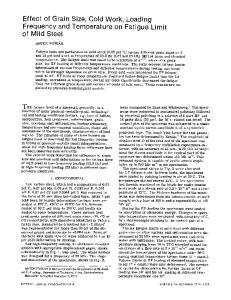Effects of Loading Frequency on Fatigue Behavior, Residual Stress, and Microstructure of Deep-Rolled Stainless Steel AIS
- PDF / 1,118,701 Bytes
- 6 Pages / 593.972 x 792 pts Page_size
- 14 Downloads / 315 Views
DUCTION
THERE are several factors, e.g., stress amplitude, mean stress, and temperature, that play an important role in the fatigue behavior and performance of metallic materials. It is well established that high stress amplitude, positive mean stress, and high temperature will deteriorate the fatigue life and the performance.[1–3] The effects of the loading frequency are noticeable and recognized for a wide range of metallic materials, especially related to the very high loading frequency and the very high cycle fatigue regime.[4–7] For low and high cycle fatigue regimes, the loading frequency will be considerably pronounced if particular environments, such as high temperature or corrosion, are involved.[8,9] However, an austenitic stainless steel AISI 304 exhibits a strong dependence on loading frequencies at room temperature due to self-heating during fatigue tests in a low cycle fatigue regime, as reported in Reference 10.
I. NIKITIN is with Infineon Technology AG, D-93049 Regensburg, Germany. P. JUIJERM is with the Department of Materials Engineering, Faculty of Engineering, Kasetsart University, Bangkok 10900, Thailand. Contact email: [email protected], [email protected] Manuscript submitted July 27, 2016.
METALLURGICAL AND MATERIALS TRANSACTIONS A
At an elevated temperature, fatigue and loading frequencies play an important role because of the thermal damage and increased residual stress relaxation with prolonged exposure time, especially for the mechanically surface-treated condition, e.g., deep rolled (DR) or shot peened. That means that the fatigue life should be deteriorated if a low-frequency fatigue is involved. Additionally, at an appropriate and elevated temperature with a low strain rate (referred to as the low loading frequency), there is an interesting phenomenon called dynamic strain aging (DSA). Many steels show DSA effects due to the fact that they contain interstitial atoms, such as carbon or nitrogen, which can obstruct the dislocation movements at an appropriate temperature.[11–16] The low loading frequency should promote the beneficial effects of DSA on fatigue performance, but at the same time, the longer exposure at an elevated temperature should deteriorate the fatigue life of steels. From this point of view, the effects of loading frequency on the fatigue behavior of austenitic stainless steel AISI 304 should be systematically clarified at elevated temperatures. Furthermore, mechanical surface treatments, such as deep rolling or shot peening, are recognized to induce near-surface residual stresses and work-hardening layers, enhancing fatigue performance by retarding fatigue crack initiation and propagation.[17–23] A deep rolling process increases the fatigue life of the austenitic stainless steel AISI 304, as reported in Reference 23, due
to the lower plastic strain amplitude and the inhibition of fatigue crack growth. Fatigue crack growth is inhibited by the compressive residual stresses, whereas plastic strain amplitude is lowered due to the high work-hardening state at the surface and in
Data Loading...










